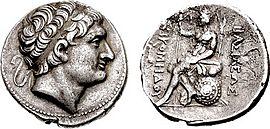Nicomedes I of Bithynia facts for kids
Quick facts for kids Nicomedes I |
|
|---|---|

Coin of Nikomedes I of Bithynia. Obverse shows head of Nikomedes diademed. Reverse shows Bendis seated; legend ΒΑΣΙΛΕΩΣ ΝΙΚΟΜΗΔΟΥ[Σ].
|
|
| Basileus of Bithynia | |
| Reign | c. 278-255 BC |
| Predecessor | Zipoetes I |
| Successor | Etazeta of Bithynia |
| Born | c. 300 BC |
| Died | c. 255 BC |
| Consort | Ditizele Etazeta |
| Issue | Ziaelas Prusias Lysandra |
| Father | Zipoetes I |
Nicomedes I (Ancient Greek: Νικομήδης; lived around 300 BC – around 255 BC, reigned 278 BC – around 255 BC) was the second king of Bithynia. He was the oldest son of Zipoetes I. Nicomedes took over the throne from his father in 278 BC.
Contents
Becoming King of Bithynia
When Nicomedes became king, he faced challenges from his brothers. One brother, Zipoetes II, even started his own separate kingdom in Bithynia for a while.
At the same time, Nicomedes was worried about an invasion from Antiochus I Soter. Antiochus was the king of the Seleucid Empire. He had already fought against Nicomedes' father.
To protect his kingdom, Nicomedes made important alliances. He first joined forces with Heraclea Pontica. Soon after, he also allied with Antigonus II Gonatas. The feared attack from Antiochus I did happen, but it caused little damage. Antiochus invaded Bithynia but then left without a major battle.
Uniting Bithynia and New Allies
Nicomedes then focused on his brother, Zipoetes II. He needed stronger help to defeat him. So, Nicomedes made an alliance with the Celts. These people had arrived near the Bosphorus strait. They were led by Leonnorius and Lutarius.
In 277 BC, the Celts were trying to capture the city of Byzantium. Nicomedes helped them cross into Asia Minor. In return, the Celts helped him. They helped Nicomedes defeat and kill his brother Zipoetes II. This allowed Nicomedes to unite all of Bithynia under his rule. The Celts later settled in Asia Minor and founded a region called Galatia.
A Peaceful and Prosperous Reign
After uniting Bithynia, not much is known about the next events. The Celts likely helped Nicomedes against Antiochus again. However, there are no detailed records of this war or the peace that followed. It seems Nicomedes was able to rule Bithynia without further major conflicts.
His reign was long and peaceful. During this time, Bithynia grew very powerful and wealthy.
Founding Nicomedia, the New Capital
Like many other Greek rulers, Nicomedes wanted to build a new capital city. This city would be named after him. He chose a very good location near the ancient city of Astakos. Astakos was a Megarian colony.
The new city was called Nicomedia. It was so well-chosen that it remained one of the richest cities in Anatolia for over 600 years. The founding of Nicomedia happened in 264 BC, according to the historian Eusebius.
Later Life and Family
The exact length of Nicomedes' reign after founding Nicomedia is not known. However, he died around 255 BC.
Nicomedes was married twice. His first wife was Ditizele, who was from Phrygia. They had two sons, Prusias and Ziaelas, and a daughter named Lysandra. His second wife was Etazeta. She convinced him to change his will. Nicomedes decided to leave his crown to her children instead of his older sons.
At the time of his death, Etazeta's children were still very young. So, Nicomedes left them in the care of two powerful kings: Antigonus II Gonatas and Ptolemy II Philadelphus. He also put them under the protection of the free cities of Heraclea Pontica, Byzantium, and Cius. However, despite these plans, his older son Ziaelas quickly took the throne.
It is believed that this Nicomedes tried to buy a very famous statue. It was the statue of Venus made by Praxiteles. He offered to cancel all the city of Knidos's public debts in exchange for the statue.
See also
 In Spanish: Nicomedes I de Bitinia para niños
In Spanish: Nicomedes I de Bitinia para niños

